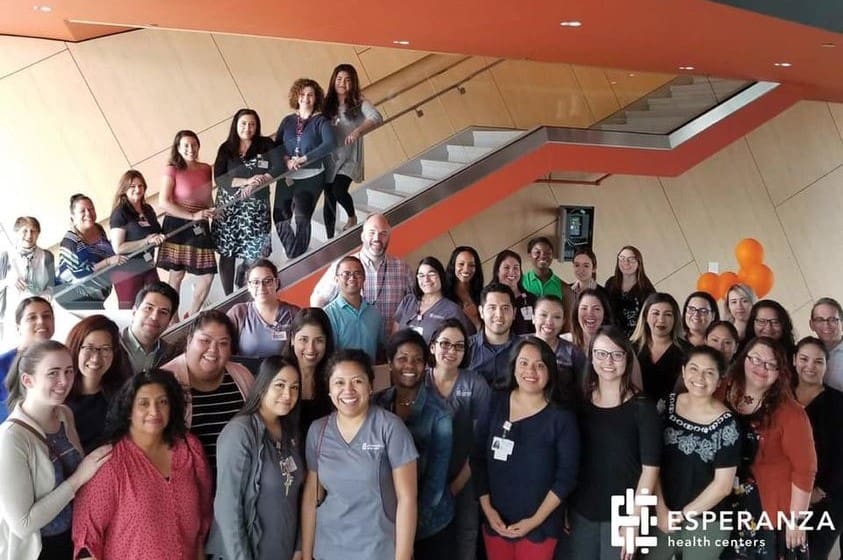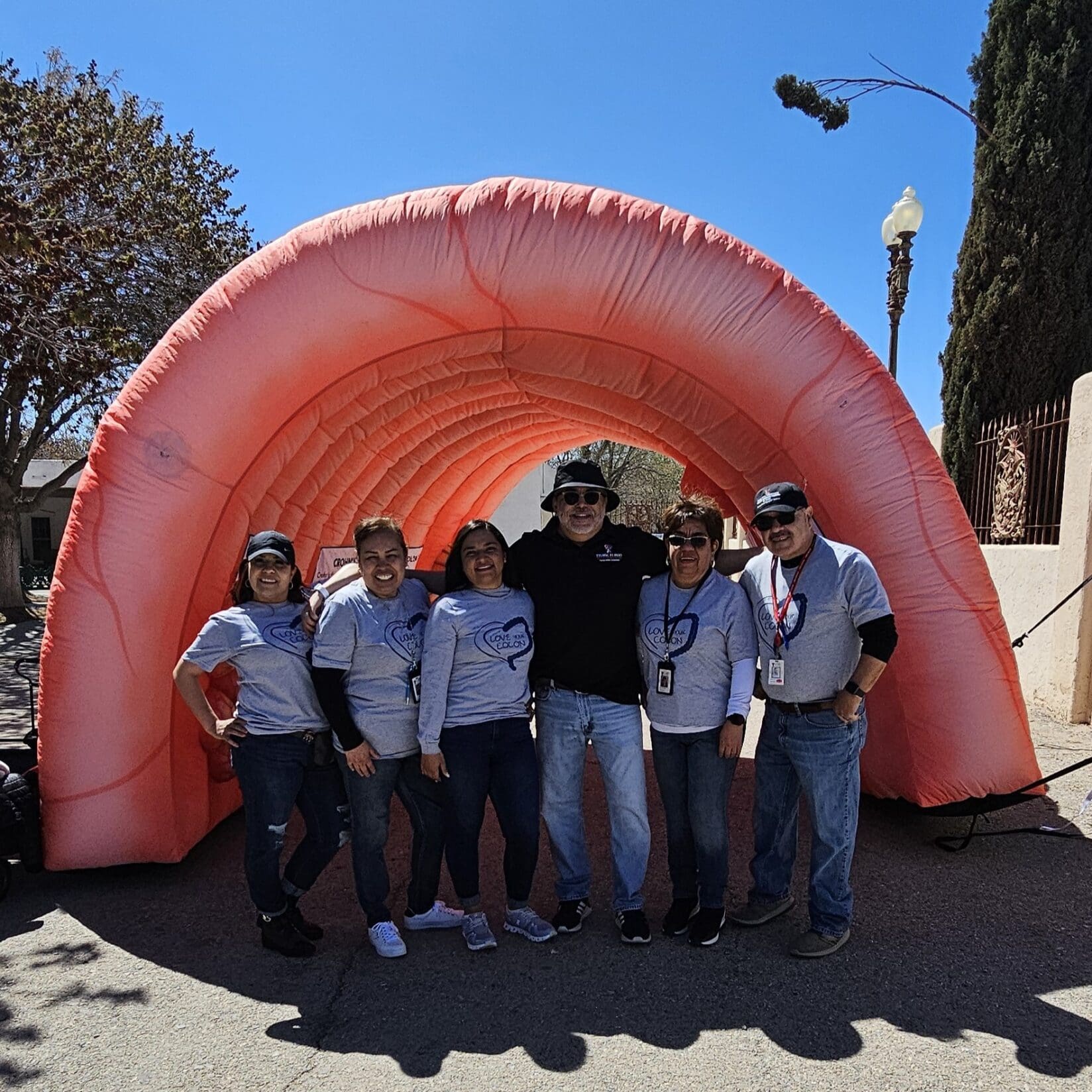Interview with Esperanza Health Centers—Recipient of the 2021 80% in Every Community National Achievement Award for Community Health Centers

October 4, 2021 – Authors: Andrew Van Wieren, MD and Ted Hufstader, MPH
On March 1, Esperanza Health Centers became the recipient of the 2021 80% in Every Community Awards, a program designed to recognize individuals and organizations who are dedicating their time, talent, and expertise to advancing needed initiatives that support the shared goal to achieve colorectal cancer screening rates of 80% and higher. Andrew Van Wieren, MD, is Chief Medical Officer, leads our team of over 70 medical and behavioral health providers, and is dedicated to expanding access to high-quality health care to underserved communities. Dr. Van Wieren’s efforts have helped Esperanza receive the National Quality Leader Award four out of the past five years, placing us within the top tier of health centers nationally for our quality of care. He graduated from the Warren Alpert Medical School at Brown University and completed his residency at Brigham and Women’s Hospital Primary Care Internal Medicine Program at Harvard Medical School. Some of his awards and affiliations include the Alpha Omega Alpha Honor Society, Gold Humanism Honor Society, and National Health Service Corps Scholar.
Andrew Van Wieren, MD, is Chief Medical Officer, leads our team of over 70 medical and behavioral health providers, and is dedicated to expanding access to high-quality health care to underserved communities. Dr. Van Wieren’s efforts have helped Esperanza receive the National Quality Leader Award four out of the past five years, placing us within the top tier of health centers nationally for our quality of care. He graduated from the Warren Alpert Medical School at Brown University and completed his residency at Brigham and Women’s Hospital Primary Care Internal Medicine Program at Harvard Medical School. Some of his awards and affiliations include the Alpha Omega Alpha Honor Society, Gold Humanism Honor Society, and National Health Service Corps Scholar. Ted Hufstader, MPH, joined Esperanza Health Centers in January 2018, bringing 12 years of expertise in health research and organizational learning and development to his role. Most recently, Ted was supporting and developing a leadership and succession planning program at Southcentral Foundation (SCF), an Alaska Native primary care system known for its transformational relationship-based care model and a two-time winner of the Malcolm Baldrige National Quality Award. Ted’s philosophy is determining what builds, drives, and sustains an organization’s culture, and he brings this approach to Esperanza’s nationally recognized quality improvement initiatives. Outside of work, you can find Ted running through Chicago’s many neighborhoods, relaxing with his cat Fuzzie Mercury, and searching for Chicago’s best chocolate chip cookie.Esperanza Health Centers was founded in 2004 with a mission to deliver health and hope for Chicago’s underserved communities. Esperanza serves primarily, but not exclusively, Latin X Mexican-American immigrant populations on the southwest side of Chicago. About 90% of their patients identify as Latin X, and they are committed to DEI efforts (diversity, equity, and inclusion) in their work.
Ted Hufstader, MPH, joined Esperanza Health Centers in January 2018, bringing 12 years of expertise in health research and organizational learning and development to his role. Most recently, Ted was supporting and developing a leadership and succession planning program at Southcentral Foundation (SCF), an Alaska Native primary care system known for its transformational relationship-based care model and a two-time winner of the Malcolm Baldrige National Quality Award. Ted’s philosophy is determining what builds, drives, and sustains an organization’s culture, and he brings this approach to Esperanza’s nationally recognized quality improvement initiatives. Outside of work, you can find Ted running through Chicago’s many neighborhoods, relaxing with his cat Fuzzie Mercury, and searching for Chicago’s best chocolate chip cookie.Esperanza Health Centers was founded in 2004 with a mission to deliver health and hope for Chicago’s underserved communities. Esperanza serves primarily, but not exclusively, Latin X Mexican-American immigrant populations on the southwest side of Chicago. About 90% of their patients identify as Latin X, and they are committed to DEI efforts (diversity, equity, and inclusion) in their work.
In 2016, Esperanza began applying a team-based care approach to increase colorectal cancer screening rates from a baseline of 43% in 2015. Screening rates climbed to 69% in 2016 and reached 80% in 2017, with rates remaining above 80% through 2019.
In 2018 and 2019, the Health Resources and Services Administration (HRSA) designated Esperanza a National Quality Leader, an honor bestowed on fewer than 5% of federally qualified health centers nationwide. During the COVID-19 pandemic, care teams focused on delivering fecal immunochemical tests (FITs) with prepaid mailers and frequent reminders.Tell us a little bit about Esperanza Health Centers and how you have been impacted by COVID-19.
We believe in and live our values of caring, quality, and family. We continuously strive to deliver high-quality patient-centered care that meets the needs of the communities we serve. Between 2016 and 2020, our health center population rose from 20,719 to 45,548 patients.
The COVID-19 pandemic disproportionately impacted the communities we serve, with a COVID-19 positive test rate of 75% in some communities. During the pandemic, we focused on the immediate needs of our community by providing health information, testing, clinical evaluation, referrals, and vaccination services.
When and why did Esperanza Health Centers decide to focus on increasing colorectal cancer screening rates?
In 2015, our baseline screening rate was 43%, and we wanted to improve this measure. The NCCRT’s 80% by 2018 goal helped to motivate and focus us on increasing our colorectal cancer screening rates. Once we set the goal for an 80% screening rate, it was hard not to go forward. It took us about four years to reach 80%.
Our approach was to get curious and look at different ways to improve access to screening, especially for our uninsured patients. For example, we incorporated FIT tests into the screening workflow because about 30% of our patients are uninsured.
What clinical practice changes did you implement to support colorectal cancer screening?
We adopted a team-based care model with a care coordinator role. In this model, every patient works with a dedicated three-person team – care coordinator, medical assistant, and provider – with each team member’s skills leveraged to reach the best patient outcomes. The care coordinators really helped by working with lists of patients, doing patient education around FIT tests, and following up on abnormal test results.
We did a lot of training to make sure that everyone felt that they were part of the team. We built the team by starting at the point of new hiring and welcoming people to the team. Being on a team is about sharing responsibility and designing systems that make it easy for people to be successful at doing the right things.
We changed our electronic health records (EHR) system to one that had strong population health tools that could provide us with monthly dashboard reports. The dashboard data enabled us to identify the care teams that were exceeding their goals and capture and share their best practices. You cannot improve if you do not know where you are and whether your interventions are helping. The dashboard really helped us to see that information.
The EHR system also allowed our care coordinators to directly order FIT tests without a provider being involved. That enabled patients to access FIT testing without needing to come in for a visit. Instead, they received their FIT tests simply because they were on our panel of patients. Providers signed off on FIT tests in batches, and the care coordinators followed up to get the FIT tests back for analysis.
Communication is important for patients and follow-up because patients don’t always return the FIT tests on time. For example, our care coordinators sometimes call patients a number of times before getting the FIT test back. Our normal policy is to do two phone calls and a letter, but sometimes messages alone are not good enough. Some people require more help to return their FIT test because of health literacy or social determinants of health factors. In those cases, a persistent care coordinator can make a big difference.
Benchmarking our measures helped to motivate the teams through competition and improvement. We used data dashboards and business intelligence to do some visualization of the data. When the data told a story, it enabled people to discuss how they wanted to respond. We revised the designs of the dashboards based on team member feedback. For example, some people wanted a comparison report showing how they were doing compared to the previous year. The data visualizations from the EHR helped us to get new perspectives.
One of our strategic goals is to be in the first quartile for all the Uniform Data System (UDS) measures. The competition aspect keeps the teams motivated to improve their thinking about how to make screening accessible and how to accompany patients through the screening journey. We also have a quality subcommittee of our board, and we try to build an open culture for curiosity and new ideas. We are saying, doing, and living our values, which is very important.
What advice would you offer to other health centers that would like to implement a team-based care approach to colorectal cancer screening?
We recommend that health centers find an EHR system that facilitates their team-based population health approach. Find an EHR that provides informative dashboards, monthly reports, and lists of patients to work from.
Additionally, set SMART (specific, measurable, achievable, realistic, timely) but audacious goals for motivation, and then work on step-by-step incremental achievements toward the big goals. Keep yourself accountable for those incremental achievements and keep pushing toward them.
Finally, ensure that you have institutional buy-in and investment. Reaching big goals does not happen magically; people must be hired, and money must be spent. We have built a brand of quality for our system, and that’s the #1 advertisement that you can have. Our reputation is behind a lot of the growth success that we have had.
What success have you seen? How did you measure that success?
We look at success measures at both the team level and across the whole clinic. We share the team dashboard results with teams every month, and the Practice Transformation Associates work with teams to understand the data and set new goals.
We like FIT tests because, as a quality measure, the model of colorectal cancer screening with a FIT test is easy to explain, and it’s a workflow that people can understand and operate successfully. When the teams see their team data, they get motivated, and the teams set their own goals.
Our colorectal cancer screening rate has fallen below 80% for now because the pandemic caused our rate to drop. But the current rate is still a large improvement over our 2015 baseline rate. Our goal for this year is 70% because many patients won’t come into the health center because of the pandemic.
Were there tools, trainings, or resources that you found helpful?
The 80% by 2018 national goal was helpful and was very encouraging along the way. Our local American Cancer Society representative, Emmanuel Zambrano, was also a great cheerleader and very supportive.
Do you have any final tips for our readers who are working to achieve 80% in Every Community?
Invest in making small incremental steps toward your big impact goals. That way, people won’t get overwhelmed – they can start smiling and growing fast. Perfect!
Thank you for sharing your story with us! We look forward to hearing more about your work and the Esperanza Health Center’s progress in the future.[vc_widget_sidebar sidebar_id=”sidebar-1″][vc_tweetmeme][vc_facebook]
We Highlight Successes, Leaders, Best Practices, And Tools That Are Making An Impact In The Nationwide Movement To Reach 80% Screened For Colorectal Cancer.
Do you have a suggestion for a future blog topic? We welcome you to share your suggestions by emailing [email protected].
Blog Policy
Opinions expressed in these blog posts are that of the author and do not represent policies of the National Colorectal Cancer Roundtable or the author’s institution.
Our staff moderate all comments on the 80% Blog. While we do not censor based on point of view, we will delete or edit comments that are offensive or off topic. Click here to view full version.
© 2024 American Cancer Society National Colorectal Cancer Roundtable. All rights reserved.


